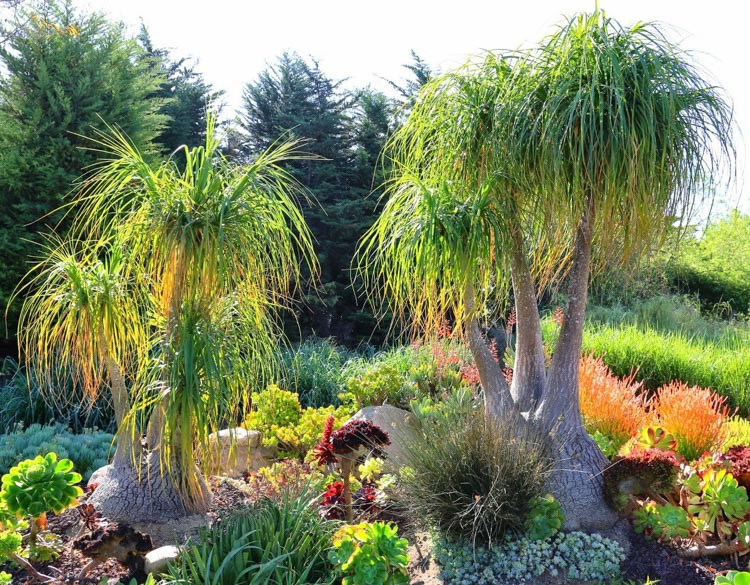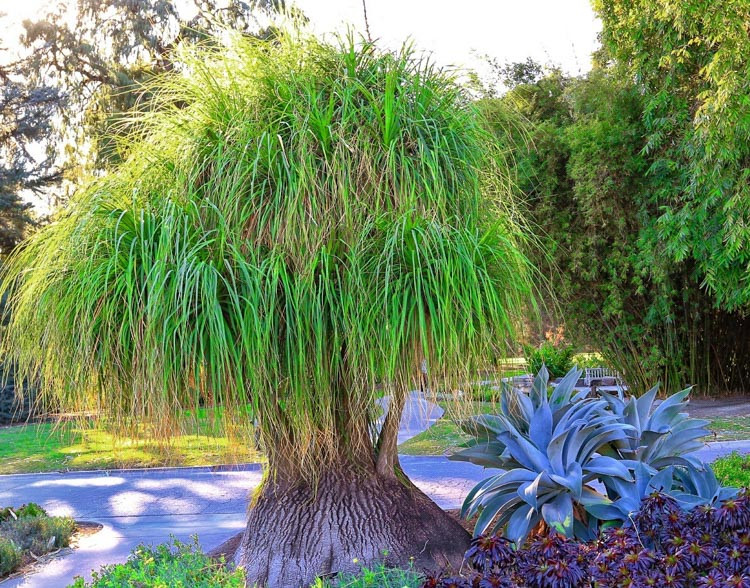Pony Tail Palm, Ponytail Palm, Pony Tail, Elephant's Foot, Bottle Palm, Nolina recurvata
An exclamation point in the landscape, Beaucarnea recurvata (Ponytail Palm) stands out with its unique shape and easy-care nature. Whether grown indoors as a statement piece or outdoors in a rock garden, it adds an exotic flair to any setting. Its adaptability, non-toxicity, and drought tolerance make it a versatile and attractive choice for a variety of gardening needs.
Beaucarnea recurvata, commonly known as the Ponytail Palm or Elephant Foot Tree, is a distinctive and popular plant both for indoor and outdoor gardening. It is characterized by its swollen, bulbous base, often likened to an elephant’s foot, which tapers into a slender, upright stem. From the top of the stem grows a crown of long, cascading leaves that resemble a ponytail, giving the plant its common name. It’s often mistaken for a palm but is actually a member of the Asparagaceae family, along with asparagus, agave, and yucca.
Native: Native to semi-desert areas of southeastern Mexico, Belize, and Guatemala, it thrives in dry, rocky landscapes.
Plant Type and Habit: The Ponytail Palm is a slow-growing, evergreen shrub or tree forming a bulbous trunk-like stem crowned with a dense rosette of long, downward-curving, bright green, grassy leaves. The greatly swollen base of the trunk (caudex) stores water just like a camel’s hump, enabling this plant to go dry for long periods. The trunk is usually single with young plants, but several smaller trunks and some sparse branching near the top may develop with age.
Size: In its natural habitat, it can grow up to 30 feet (9 meters) tall. However, when grown as a houseplant or in non-native outdoor environments, it usually reaches between 6 to 8 feet (180-240 cm) in height and 3-5 feet (90-150 cm) in width.
Flowers: The Ponytail Palm produces small, white flowers on long panicles in the summer, but flowering is rare, especially indoors. The plant may produce small, inedible fruits after flowering, but this is rare outside of its native habitat.
Foliage: Its foliage consists of long, narrow, and curly green leaves that can grow up to 6 feet (180 cm) long, cascading down like a ponytail.
Bark: The bark is thick and brown, providing a sturdy support for the plant.
Uses: Primarily used as an ornamental plant, it’s popular in drought-tolerant landscapes and as a houseplant due to its unique appearance and low maintenance.
Award: Recipient of the prestigious Award of Garden Merit of the Royal Horticultural Society.
Hardiness: It is hardy in USDA zones 10 to 11 and prefers a warm climate.
Toxicity: The Ponytail Palm is non-toxic to humans and pets, making it a safe choice for households with animals.
Deer and Rabbit: It is generally resistant to deer and rabbits, making it suitable for gardens prone to these visitors.
Drought: One of its most notable features is its exceptional drought tolerance. The bulbous base stores water, allowing the plant to withstand long periods of dryness.
Invasiveness: This plant is not considered invasive. Its slow growth rate and specific growing requirements limit its spread in non-native environments.
Benefits: Besides its ornamental value, it is an excellent plant for improving indoor air quality. It also requires minimal care, making it ideal for those who want greenery without extensive gardening chores.

Ideal Location: Place your Ponytail Palm in a spot where it can receive bright, indirect sunlight, like near a south or east-facing window. It can tolerate lower light conditions but may grow slower.
Soil Requirements: Use a well-draining soil mix, typically a cactus or succulent potting mix, to ensure proper drainage and prevent root rot.
Watering: Water sparingly. Allow the soil to dry out completely between waterings. The swollen trunk base stores water, making the plant drought-tolerant. Overwatering is a common mistake and can lead to root rot.
Temperature and Humidity: The Ponytail Palm prefers average room temperatures (65-75°F) and can tolerate dry indoor air but will appreciate occasional misting.
Fertilizing: During the growing season (spring and summer), feed the plant with a diluted, balanced fertilizer once every month or two.
Pruning: Minimal pruning is needed. Remove any dead or yellowing leaves to maintain its appearance.
Repotting: Repot every few years or when the plant becomes root-bound. Use a container only slightly larger than the previous one, as too much space can lead to overwatering issues.

Location: In outdoor settings, plant your Ponytail Palm in an area with full sun to partial shade. In extremely hot climates, afternoon shade is beneficial.
Soil: It thrives in sandy, moderately fertile, sharply drained soil.
Watering: While the plant is drought-tolerant, regular watering helps it grow more robustly, especially in the first few years. Water deeply but infrequently, allowing the soil to dry out between watering sessions.
Climate: Hardy in USDA zones 10-11, the Ponytail Palm can tolerate some cold but should be protected from frost. In cooler climates, it can be grown in containers and brought indoors during winter.
Fertilizing: Use a balanced fertilizer in spring and summer, reducing frequency as the plant matures.
Pruning: Trim off any dead leaves or spent flower stalks. Avoid over-pruning, as the plant grows slowly.
Landscape Use: The Ponytail Palm is excellent for adding a tropical or desert-like feel to landscapes, rock gardens, or as a standalone specimen.
Propagation: While slower, it can be propagated in spring from seed or more commonly by separating offsets that form at the base.
The Ponytail Palm is generally a low-maintenance plant, but like all plants, it can encounter some issues with pests, diseases, and other common problems:
Spider mites: These tiny pests can cause yellowing or browning of leaves. They thrive in dry conditions, so increasing humidity can help prevent infestations.
Mealybugs: These small, cottony pests suck sap from the leaves, weakening the plant. They can be removed with a cotton swab dipped in alcohol.
Scale insects: Appearing as small bumps on the leaves or stem, they feed on the plant’s sap. They can be scraped off or treated with insecticidal soap.
Root rot: This is the most common problem, usually caused by overwatering. Ensure proper drainage and let the soil dry out between waterings to prevent it.
Leaf spot: Fungal or bacterial leaf spot can occur, especially in overly moist conditions. Improve air circulation and reduce leaf wetness to manage it.
Brown Leaf Tips: Often caused by dry air or inconsistent watering. Ensure a consistent watering schedule and consider using a humidifier if indoor air is too dry.
Soft Trunk: A soft or mushy trunk is a sign of overwatering and potential root rot. Reduce watering and check if repotting with fresh, well-draining soil is necessary.
Lack of Water: While drought-tolerant, prolonged lack of water can lead to wilting or curling leaves.
Inadequate Light: The plant may become leggy if it doesn’t receive enough light. Ensure it gets enough indirect sunlight.
| Hardiness |
10 - 11 |
|---|---|
| Heat Zones |
10 - 11 |
| Climate Zones | 13, 16, 17, 18, 19, 20, 21, 22, 23, 24, H1, H2 |
| Plant Type | Houseplants, Shrubs, Trees |
| Plant Family | Asparagaceae |
| Common names | Ponytail Palm, Elephant's Foot, Bottle Palm |
| Exposure | Full Sun |
| Season of Interest |
Spring (Early, Mid, Late) Summer (Early, Mid, Late) Fall Winter |
| Height |
6' - 8' (180cm - 240cm) |
| Spread |
3' - 5' (90cm - 150cm) |
| Spacing | 60" (150cm) |
| Maintenance | Low |
| Water Needs | Low |
| Soil Type | Chalk, Clay, Loam, Sand |
| Soil pH | Acid, Alkaline, Neutral |
| Soil Drainage | Well-Drained |
| Characteristics | Plant of Merit, Showy, Evergreen |
| Tolerance | Drought, Deer |
| Garden Uses | Beds And Borders, Patio And Containers |
| Garden Styles | Mediterranean Garden, City and Courtyard |
| Hardiness |
10 - 11 |
|---|---|
| Heat Zones |
10 - 11 |
| Climate Zones | 13, 16, 17, 18, 19, 20, 21, 22, 23, 24, H1, H2 |
| Plant Type | Houseplants, Shrubs, Trees |
| Plant Family | Asparagaceae |
| Common names | Ponytail Palm, Elephant's Foot, Bottle Palm |
| Exposure | Full Sun |
| Season of Interest |
Spring (Early, Mid, Late) Summer (Early, Mid, Late) Fall Winter |
| Height |
6' - 8' (180cm - 240cm) |
| Spread |
3' - 5' (90cm - 150cm) |
| Spacing | 60" (150cm) |
| Maintenance | Low |
| Water Needs | Low |
| Soil Type | Chalk, Clay, Loam, Sand |
| Soil pH | Acid, Alkaline, Neutral |
| Soil Drainage | Well-Drained |
| Characteristics | Plant of Merit, Showy, Evergreen |
| Tolerance | Drought, Deer |
| Garden Uses | Beds And Borders, Patio And Containers |
| Garden Styles | Mediterranean Garden, City and Courtyard |
How many Beaucarnea recurvata (Ponytail Palm) do I need for my garden?
| Plant | Quantity | |
|---|---|---|
| Beaucarnea recurvata (Ponytail Palm) | N/A | Buy Plants |
Create a membership account to save your garden designs and to view them on any device.
Becoming a contributing member of Gardenia is easy and can be done in just a few minutes. If you provide us with your name, email address and the payment of a modest $25 annual membership fee, you will become a full member, enabling you to design and save up to 25 of your garden design ideas.
Join now and start creating your dream garden!
Create a membership account to save your garden designs and to view them on any device.
Becoming a contributing member of Gardenia is easy and can be done in just a few minutes. If you provide us with your name, email address and the payment of a modest $25 annual membership fee, you will become a full member, enabling you to design and save up to 25 of your garden design ideas.
Join now and start creating your dream garden!